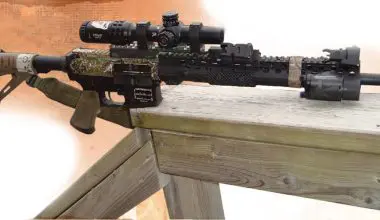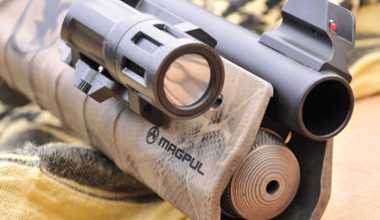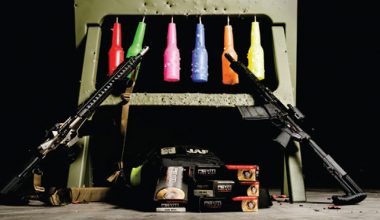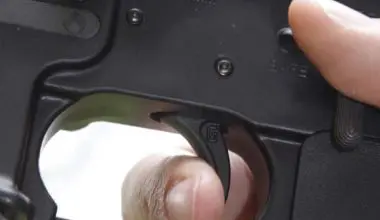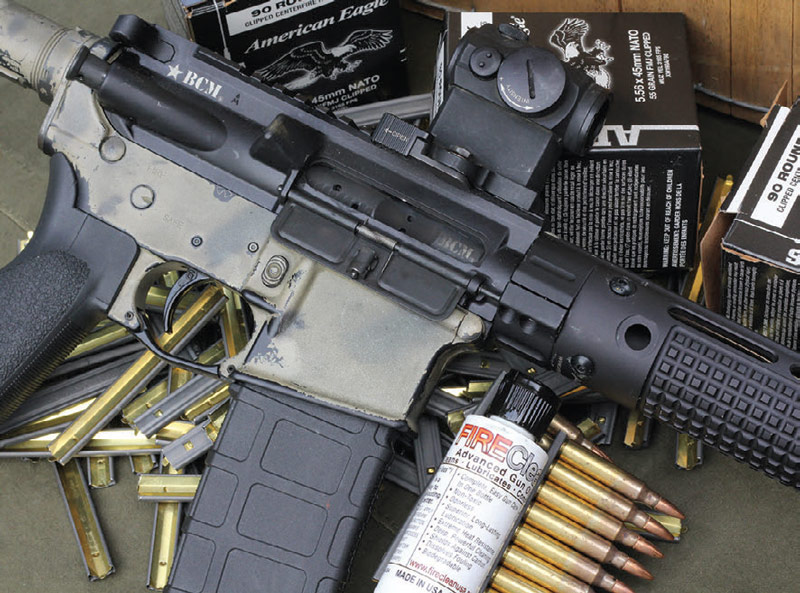
For years the pat answer for reliability problems with semiautomatic rifles or handguns was to replace the magazine and lubricate the action. Magazines have come a long way in the last few decades across all platforms, as has understanding that the box magazine is a consumable item that will eventually need replacement.
That leaves lubrication.
Many shooters are still using traditional lubricants that were designed before the first computer. These products still work, but like advances in all other aspects of shooting, improved lubricants have been hitting the market at a rapid rate. These lubes typically offer better staying power on surfaces, are more “slippery” and reduce friction better, contribute to easier cleaning, and are either non or less toxic than traditional petroleum-based products.
OK, blah-blah, whatever—lubrication can seem as exciting as talking about a better toothpaste. But some of the best new lubricants are offering performance increases that are worth turning the page for. FireClean is one of these.
FireClean has been quietly sweeping the high-end shooting circles. I became aware of the product early on and yawned, stretched, and went back to what I was doing. Outrageous claims are commonplace in the lubricant sector, and I had a supply of products that performed quite adequately.
Then in the space of a month, I heard rave reviews of FireClean from two shooting buddies who instruct in two different branches of the SOF community and are highly knowledgeable and skilled high-volume shooters. I took a sample and put it into rotation.
That was three years ago, and gradually FireClean displaced all the other bottles on my gun table. It is a unicorn in the oil business—the impressive claims are simply borne out in use. It is non-toxic, which is good for the user and hugely significant for organizational application, where environmental compliance is a massive burden.
The lube stays in place like nothing I have used, yet doesn’t seem to gum up. FireClean is the slickest lube I’ve yet experienced, challenging moly grease for its ability to change the feel of parts contacting into a silky transition. The slickness and staying-thereness are hard to reconcile with an odorless oil that is as thin as FireClean.
The “and wait, there’s more!” part is that cleanup of hard-used, highround- count uppers or pistol slides becomes a wipe it off with a paper towel affair. I was pretty happy with some earlier non-toxic lubes that outperformed traditional milspec CLPs (Cleaner, Lubricant, Preservative), but the more I used FireClean, the more impressed I became.
During this time frame, I also dabbled with a few other offerings that had recently come to market. Simply put, some were more sizzle than steak; new doesn’t automatically mean better.
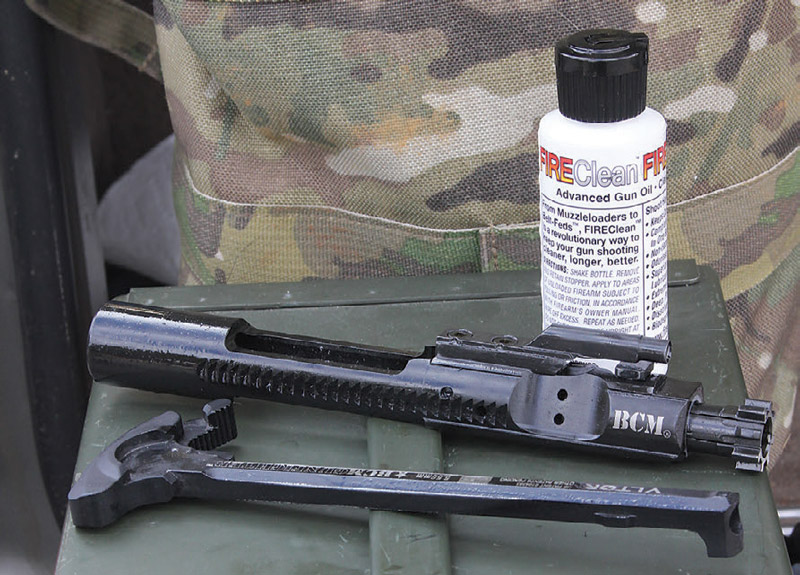
Table of Contents
THE TEST
This year FireClean approached me with a proposal: Take a random basic milspec upper, lubricate it with Fire- Clean, and see how far it would go on that initial lubrication. No spot lubrication in-stride, no cleaning, nothing other than shoot the carbine and see what happens.
This sounded like an interesting project. I had successfully taken previous uppers through higher-than-average round counts between lube touchups with FireClean, and was curious to see just how far is too far.
Basic parameters were set. We chose a Bravo Company Mfg upper with a milspec bolt carrier group, dropped it onto a Noveske N4 lower with a Magpul Slimline stock and VTAC Super V trigger, and secured six new Gen 3 PMAGs from Magpul to be the exclusive mags used throughout. Ammo was Federal American Eagle XM193 on stripper clips.
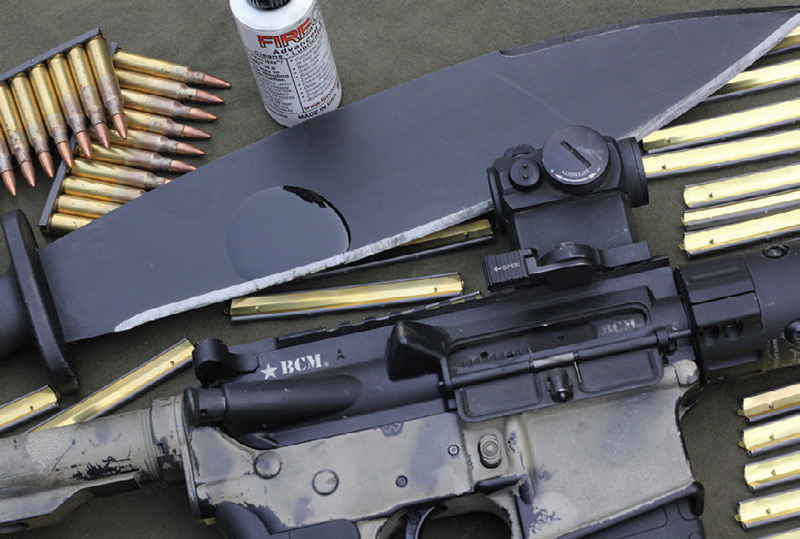
CONTEXT
A spectrum of lubrication regimens exists. On the one hand, you have the “shoot it, clean it obsessively, and lubricate it each time” camp. On the other is the “keep adding lube until reliability is affected or the sludge oozing out of the action becomes a distraction” camp. Both work.
The “add lube” approach is pretty common among high-round-count (1,000 to 1,500 rounds) carbine classes, and every instructor I’m familiar with tends to recommend something like lubrication at mid-day, or about every 250 rounds. In an operational setting, experienced shooters tend to check carefully before each mission and more likely than not will add a drop or two of lubricant to key areas.
Bone dry is a minefield of problems, and I have seen clean and dry weapons become sluggish or start to have problems in as little as 100 rounds.
Some other numbers are helpful in the background. I recently polled a number of my teammates with experience across multiple deployments to different highly active areas in Iraq and Afghanistan. Each identified the average rounds fired per man from the M4 on “average” offensive missions in a bracket from 15 to about 35 rounds, depending on the area and whether the mission was direct action or area clearance.
When asked about the epic, dayslong battle with resupply scenarios, each recalled a very similar figure of about 220 to 250 rounds. (Belt-fed weapons, of course, were a different story!)
FIRE(CLEAN) IT UP
Upon project kick-off, Ed from Fire- Clean showed me how he has come to treat the whole action, not simply the bolt. He recommended getting a good film of the lube (with about 20 to 28 drops) on the entire bolt, carrier, and interior of the upper. He emphasized the locking area of the barrel extension, where the bolt twists in and out of upon locking and unlocking. He also emphasized the action spring, buffer, and receiver extension. Freshly treated with Fire- Clean, the rifle had a silky smooth feel upon cycling. The bolt locked and unlocked with no hesitation.
We then proceeded to shoot the snot out of it. At key intervals, we stopped to examine the rifle and document its condition while we refilled the PMAGs.
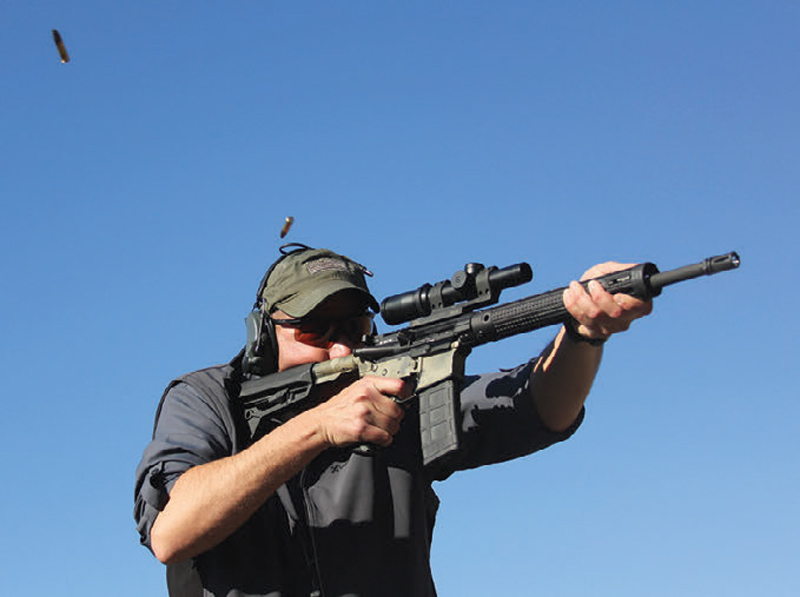
180 ROUNDS
At the end of six magazines of M193, the rifle was absolutely unremarkable. It cycled the same as round one, the bolt showed the same wet sheen as upon application, and just the slightest tinge of carbon was near the vent holes. I am pretty sure I could have convinced any shooter accustomed to military CLP or similar that the rifle had less than 30 rounds through it.
Also worth noting is there was no “spray” or splatter when shooting commenced as is common with some lubes when applied as liberally as the FireClean was. It stayed put and there was no smeary mist on the eye protection.
500 ROUNDS
When the rifle hit 500 rounds, we took a break to let it cool and checked out the innards. A little more accumulation of soot was on the bolt’s indentation, but no difference in feel and, if I wasn’t counting rounds, I would have no inclination to add any lube in a different setting.
1,000 ROUNDS
At the end of a solid training day, we had 1,000 certified rounds on the gun. As you can see in the picture at the bottom of this page, there was a little soot, but on the whole the bolt retained an oiled appearance on all reciprocating parts and surfaces.
Again, I suspect I could convince an experienced bystander that the weapon had less than half of the actual round count through it by appearance. The feel when cycling the action was still smooth and wet, just not quite as magically slippery as when shooting commenced.
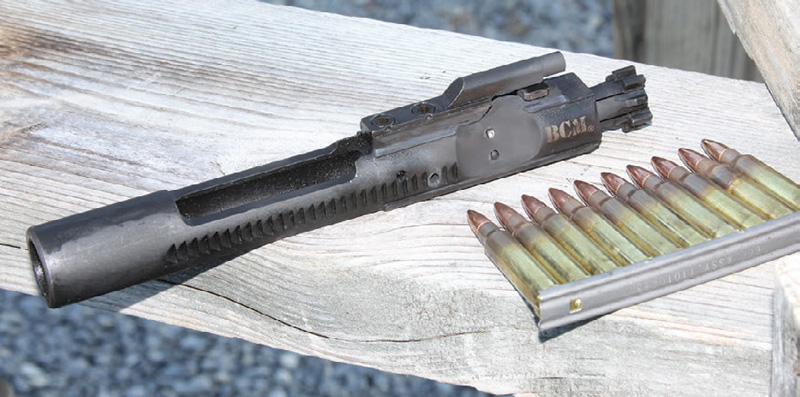
2,000 ROUNDS
Two weeks and two training sessions later, the rifle was at 2,000 rounds of the 55-grain XM193. The rifle had remained in my sole possession and had not been cleaned in any way or had any lubrication added. The one change was that at 1,300 rounds, I added a BCM Gunfighter compensator to the end of the barrel.
As an aside, the little birdcage profile comp made a dramatic difference in recovery. After 1,300 rounds in short order on the same rifle, it was quite noticeable how much faster I could follow up and how flat the rifle stayed. I have used the longer BCM comp on 14.5-inch barrels extensively, but the shorter unit on this 16-inch barrel exceeded expectations.
The rifle cycled exactly as one would expect it to, with no sluggishness whatsoever. At the 2,000-round mark, it was starting to look a little dirty and the oily sheen was visible in spots but not prevalent.
There was no tactile friction or resistance even when opening the bolt slightly to perform a chamber check and slowly returning the charging handle. This is a particularly telling sign. Many rifles that are traditionally lubricated at intervals and are at this many rounds would sluggishly respond to a chamber check or require an assist to fully return to battery.
2,430 ROUNDS
Seven weeks, six range trips, and 2,430 rounds from lubrication, I swapped the optic from a Bushnell 1-6.5X to my world-travelled Aimpoint T-1. At this point, the rifle cycled smoothly but without as wet a feel to it.
Left to my own devices, I might have chickened out and added a drop or two of lube, but the FireClean crew reassured me the rifle was good to go. We scheduled a training day to get over the hump with our remaining XM193.
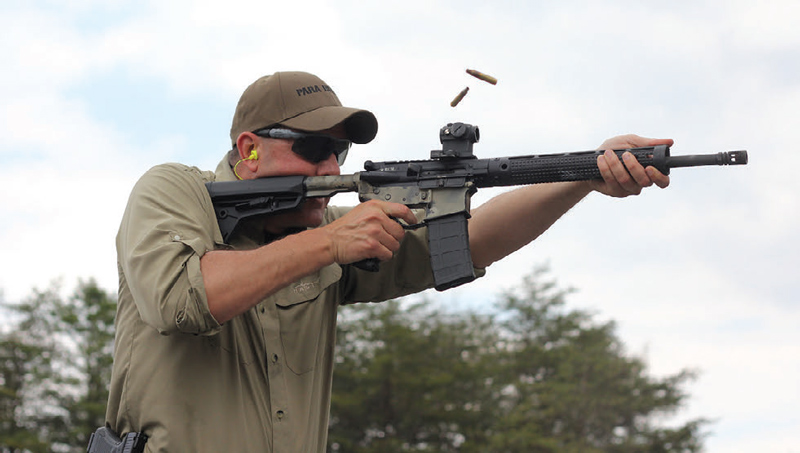
3,000 ROUNDS
Nineteen PMAGs of 5.56 later, the BCM upper was at 3,000 rounds. No stoppages, no pushing on the forward assist to chamber rounds, no drama of any sort. The photo on page 87 shows the bolt’s condition. It was dirty but much less so than other bolts I’ve seen with half as many rounds and steady lube. Cycling the action was still smooth.
There was a slightly dirty feel, but not that dry, with a sluggish feel that says “lube me!” The carbon on the bolt carrier was soft rather than baked on, and my experience with the oil on other uppers assures me that the weapon could be returned to a remarkably clean state with nothing more than a paper towel.
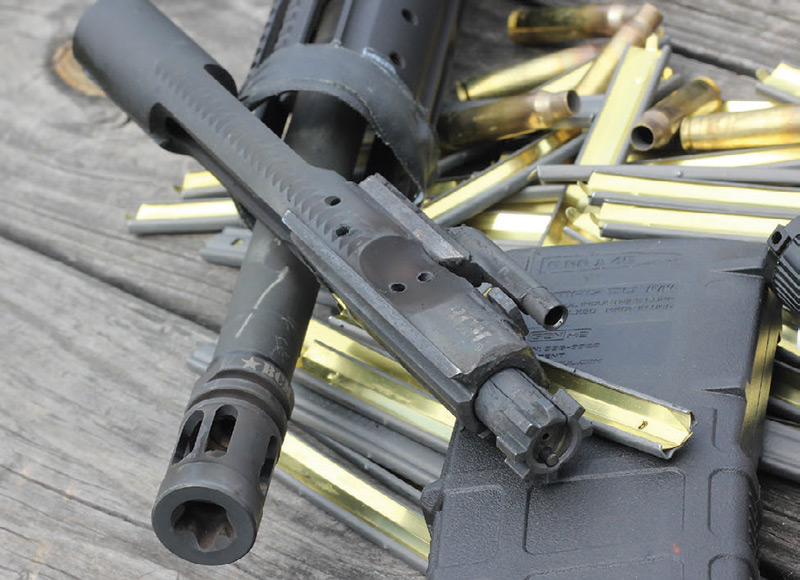
3,090 ROUNDS
When I looked at the calendar and realized the rifle was six months from its initial and only lubrication, I decided to take it back out and get a quick training session in.
The bolt was unchanged from its condition and feel months prior as I loaded up the PMAGs with some Hornady Steel Match 55-grainers. The BCM upper purred through three magazines, bringing the total on the gun to 3,090 rounds across six months and eight sessions.
That is pretty remarkable performance. From the condition of the bolt and upper, I would not be able to predict how much longer it would run, but it seems like it could go on for quite a while.
SUMMARY
It is worth repeating that this was an endurance test for data purposes. I would not choose to depend on a rifle six months out and over 3,000 rounds from cleaning or lubrication in an operational setting. It is nice to know I could probably do so, but why tempt fate?
There are over 150 unique firearmsspecific lubrication offerings on the market. I’m not sure many could equal that performance and wouldn’t expect any to be capable of doing so until they proved otherwise. If some can, then it’s all good for the consumer.
The lubrication sector of the industry is fiercely competitive, and plenty of shooters are strangely attached to their brand of choice, their celebrity endorser, or their home-brew mix of motor oil and whatnot.
With many of the latest non-toxic (and typically higher priced) lubricants, you can find a variety of Internet accusations that they are simply this or that repackaged. The nature of the Internet will ensure these rumors multiply and recycle. I am less concerned with the specific ingredients and formulation of a product than its proven performance.
The latest generation lubricants outperform traditional ones by a significant margin. FireClean is at the leading edge of that development.

